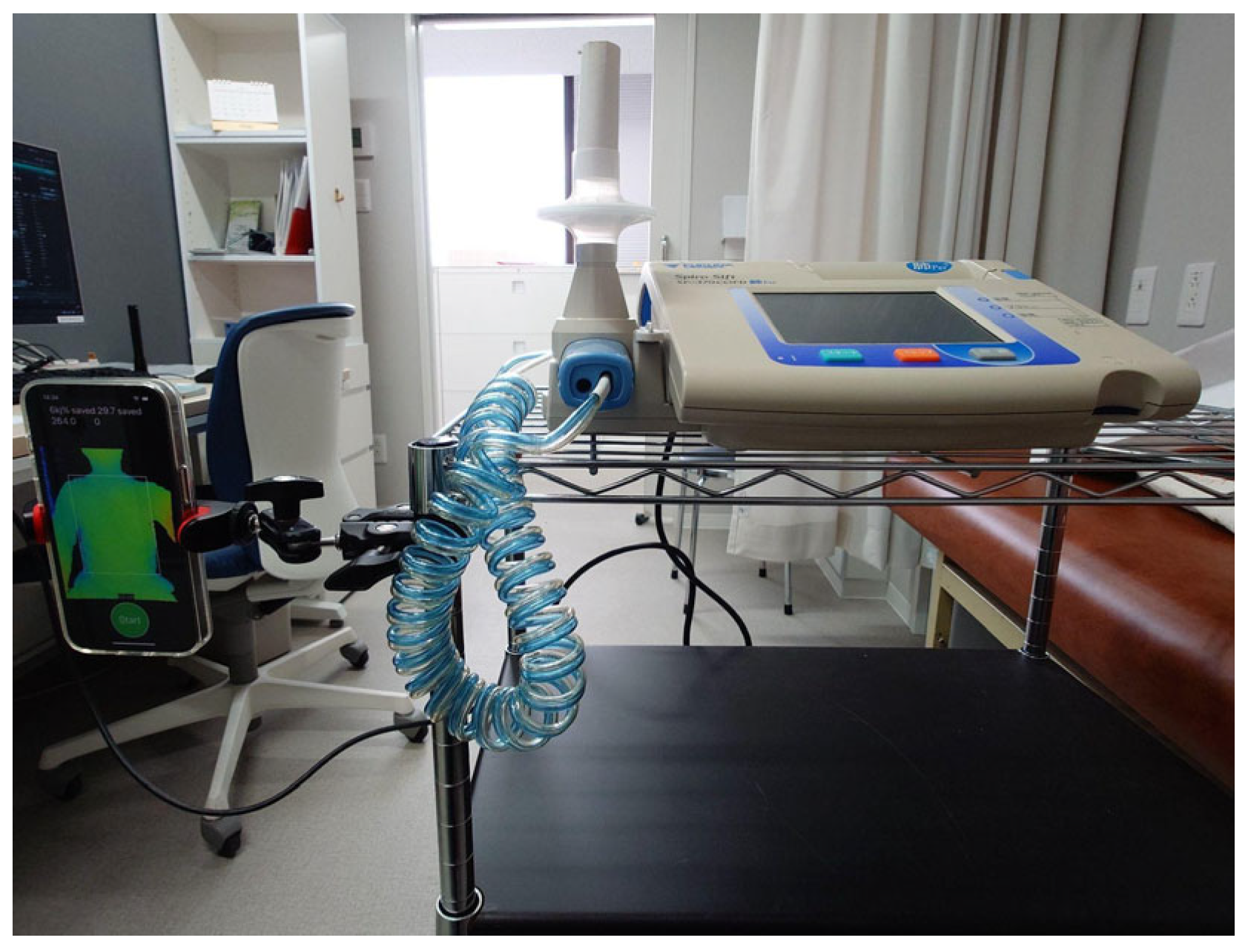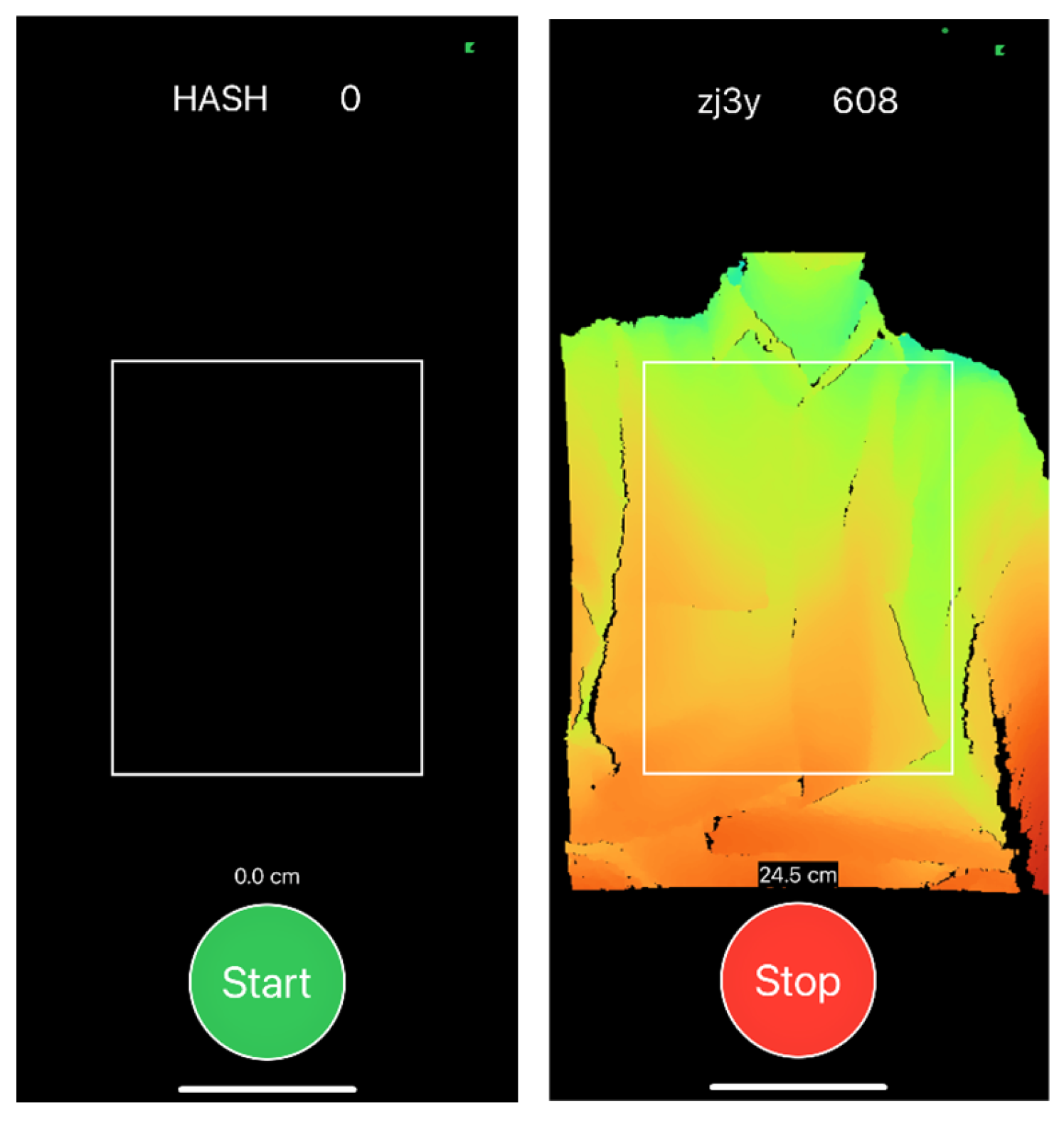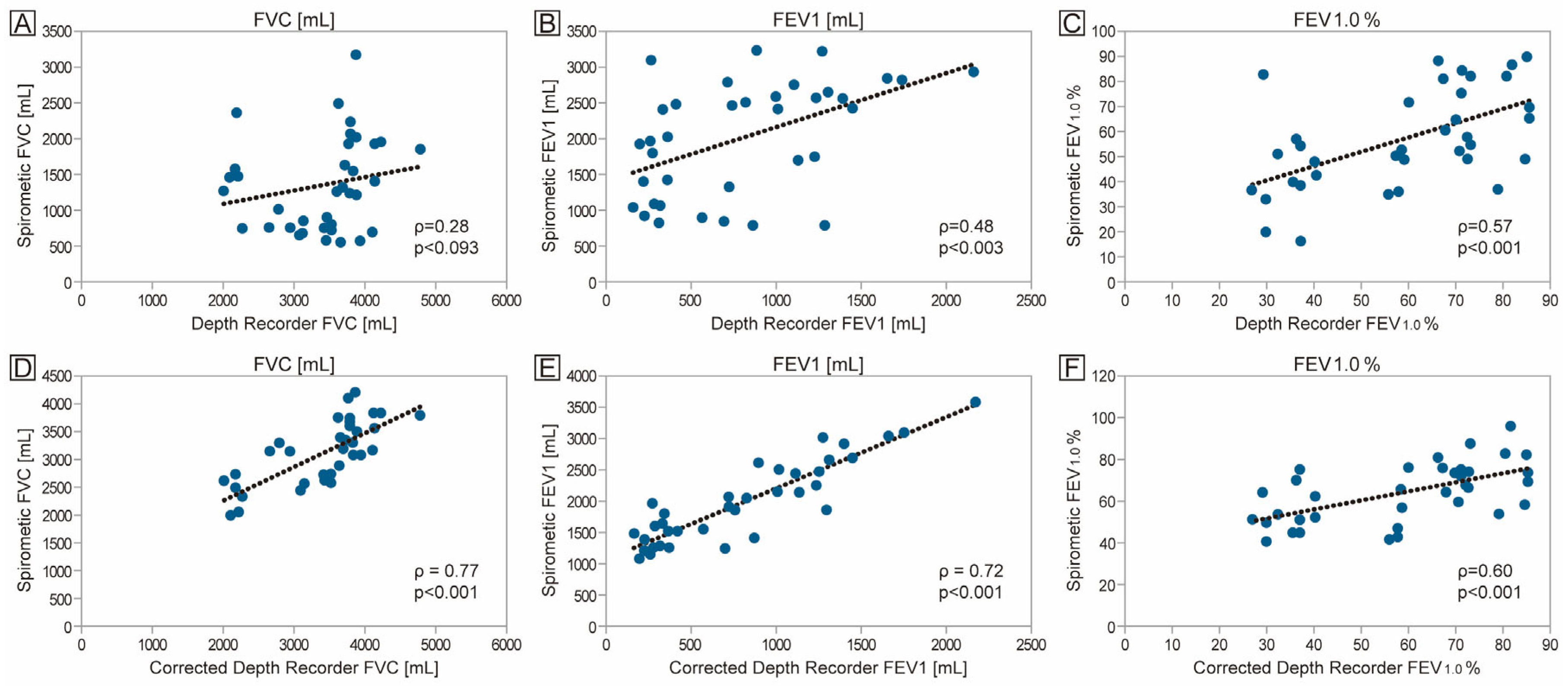1. Introduction
Relapsing polychondritis (RP) is a rare, autoimmune disorder characterized by recurrent inflammation and destruction of cartilaginous tissues. Airway involvement, such as subglottic stenosis, central airway stenosis, and airway malacia, significantly impacts disease progression and patient outcomes [
1]. Standard treatment options typically include systemic corticosteroids, immunosuppressive agents, and biologics [
2]. In severe cases of subglottic stenosis, tracheostomy may be required. For patients with airway malacia, non-invasive or invasive positive pressure ventilation can provide temporary relief; however, interventional bronchoscopy may become necessary when airway obstruction is unresponsive to these methods [
3].
Spirometry remains the gold standard for evaluating airway obstruction, but it may be impractical or impossible in patients with tracheostomy or severe airway compromise. Imaging tools such as computed tomography (CT) and positron emission tomography (PET)/CT have shown utility in assessing airway structure but pose limitations due to radiation exposure and cost [
4]. A previous report showed chest CT parameters may serve as a spirometry alternative, though frequent assessment remains difficult.
Several studies have investigated thoracic motion as a non-invasive method of assessing respiratory function. Kaneko et al. measured thoracic cage and abdominal wall movements in heathy subjects using a 3D motion analysis system, reporting the influence of age, posture, and gender on movement amplitude [
5]. Similarly, Blanco-Almazán et al. modeled the contribution of thoracic movement and respiratory volume to thoracic bioimpedance, showing that a combined model yielded minimal error [
6]. These studies support the potential of thoracic motion analysis as a tool for respiratory assessment.
Recently, a non-contact early airflow limitation screening system (EAFL-SS) was developed that enables home-based respiratory evaluation [
7]. This prototype used a time-of-flight (ToF) depth sensor to visualize anterior thoracic motion. Previously, a noninvasive, noncontact method using depth sensor was reported in patients with central airway stenosis [
8]. Based on these prior findings, the present study investigated the feasibility of using the TrueDepth camera, which employs a structured light system, to assess anterior thoracic motion in patients with RP. The objective was to evaluate whether the DepthRecorder application could serve as a non-invasive alternative to spirometry in cases where conventional lung function testing is not feasible.
2. Materials and Methods
2.1. Patient and Public Involvement
Patients or the public were not involved in the design, conduct, reporting or dissemination plans of this research.
2.2. Study Design and Participants
This prospective study enrolled 12 patients with RP who attended the outpatient clinic at St. Marianna University Hospital between October and December 2024. All participants underwent simultaneous respiratory assessments using both conventional spirometry and the DepthRecorder application, which analyses thoracic motion.
2.3. Device and Measurements
Measurements were obtained using a smartphone-based application, DepthRecorder, which captures anterior thoracic movements in real time via the TrueDepth camera on an iPhone 13 Pro®. The application was based on principles adapted from the previously developed EAFL-SS system, although the TrueDepth camera uses a structured light system rather than a ToF sensor.
The examinee was instructed to sit 35 cm from the device using the LCD screen as a guide. An iPhone 13 Pro
® with the DepthRecorder installed is shown in
Figure 1. When the TrueDepth camera detected the correct sitting position, DepthRecorder automatically displayed an image of the examinee’s anterior thorax on the screen. Measurements were initiated by pressing the “Start Measurement” button on the app, simultaneously with the start of spirometry. A schematic overview of the measurement process is shown in
Figure 2.
A thoracic bounding box detection algorithm was used to extract the thorax region from the captured image [
9]. The anterior thoracic depth image was binarized to remove background and objects located more than 15 cm from the initial reference plane. The algorithm also removed non-thoracic areas such as the neck and head. Readings were considered invalid if any object or individual other than the participant entered the visual field of the iPhone (
Figure 3). Sampling and analysis were performed using LabView 2019 Professional Development System software (National Instruments, Austin, TX, USA).
Respiratory function was simultaneously assessed using a standard spirometer (FUKUDA SP-370 Hyper, Tokyo, Japan), and measurements with DepthRecorder were taken during the same breath cycle. All measurements were performed in a seated position on a backless chair in an examination room, with three sets of readings per patient. Data were analyzed at Tokyo Metropolitan University.
2.4. Statistical Analysis
All analyses were performed to evaluate the correlation between spirometry values and respiratory measurements obtained using the DepthRecorder application. Spearman’s rank correlation coefficient was used to assess associations for three parameters: forced vital capacity (FVC), forced expiratory volume in one second (FEV1), and the FEV1/FVC ratio (%).
To improve accuracy and comparability, we applied a correction formula derived from multiple regression analysis in prior research involving 48 patients with COPD and 19 healthy individuals [
10]. Corrected DepthRecorder FVC (mL) was calculated as −3050.49 + 28.69 × height (cm) + 1.667 × measured FVC (mL). Corrected DepthRecorder FEV
1 (mL) was calculated as −2109.28 + 17.82 × height (cm) + 2.180 × measured FEV
1 (mL). These corrected DepthRecorder values were then compared with corresponding spirometry data using Spearman’s rank correlation. Due to the small sample size and the presence of both mild and severe cases, we analyzed data using the nonparametric Spearman’s correlation. Spearman’s rank correlation coefficient is a widely used non-parametric measure for assessing the monotonic relationship between two variables [
11].
2.5. Ethical Considerations
This study was approved by the Biomedical Research Ethics Committee of St. Marianna University School of Medicine (approval No.: 5557, approval date: 21 February 2022). All participants provided written informed consent prior to participation.
3. Results
Twelve patients with RP were included in the analysis. Two of the 12 patients had a history of asthma, and none had undergone chest surgery. The mean age was 53.8 ± 13.3 years, with six male and six female participants. The average height was 162.3 ± 10.3 cm, and the average weight was 58.3 ± 12.1 kg. Patient characteristics and respiratory function measurements are summarized in
Table 1.
Abbreviations: FVC, forced vital capacity; FEV1: forced expiratory volume in one second; FEV1/FVC (%), forced expiratory volume in one second divided by forced vital capacity, expressed as a percentage.
Figure 4A–C show the correlation between uncorrected DepthRecorder values and standard spirometry. Before correction, moderate correlations were observed for FEV
1 (ρ = 0.48,
p = 0.003) and FEV
1/FVC (%) (ρ = 0.57,
p < 0.001), while the correlation for FVC was not statistically significant.
After correction for height using validated regression formulas, stronger correlations were observed with spirometry, as shown in
Figure 4D–F. Corrected DepthRecorder FVC (mL) and corrected DepthRecorder FEV
1 (mL) showed stronger correlations with spirometry measurements. The corrected DepthRecorder FVC (mL) and corrected DepthRecorder FEV
1 (mL) were significantly correlated with spirometric measurements for FVC (ρ = 0.76,
p < 0.001), FEV
1 (ρ = 0.72,
p < 0.001), and FEV
1/FVC (%) (ρ = 0.60,
p < 0.001).
4. Discussion
This study observed significant correlations between spirometry values and DepthRecorder measurements, corrected for height, in 12 patients with airway involvement due to RP. These results suggest that DepthRecorder may serve as a viable alternative for respiratory function assessment, particularly in patients who are difficult to evaluate using conventional spirometry, such as those with tracheostomies or severe bronchial stenosis. These findings support the potential of this smartphone-based tool as a non-invasive alternative for respiratory assessment. Further research is required to refine the methodology, validate its performance in larger populations, and establish robust clinical reference standards.
Previous studies have utilized 3D depth-sensing technologies to estimate respiratory function through thoracic motion analysis [
12,
13]. While some systems, such as those used by Takamoto et al., employed ToF sensors [
7], the TrueDepth camera used in this study is based on a structured light system that also uses infrared light to capture three-dimensional surface geometry. Takamoto et al. evaluated a ToF sensor in 32 COPD patients and 21 healthy controls, demonstrating strong correlation with spirometry during forced expiration while seated. The reported sensitivity and specificity for detecting early airflow limitation were 81% and 90%, respectively, with FEV
1 values closely correlated with spirometry. These findings reinforce the utility of 3D scanning technologies, both ToF and structured light systems, for non-contact respiratory assessment. Depth cameras such as Microsoft Kinect and Intel RealSense use dot projector-based measurement methods, which are fundamentally the same as those employed by the iPhone TrueDepth camera. In preliminary experiments, we used iPhones to measure cylindrical artificial objects and found the accuracy of volume calculations to be sufficiently high. The main sources of error in this study are more likely related to the non-linear relationship between thoracic volume and lung capacity or to inter-individual variability. Accordingly, differences in equipment are unlikely to have exerted a dominant influence on the results.
The use of the TrueDepth camera offers the additional benefit of smartphone integration, potentially enabling remote and non-invasive monitoring of respiratory function. Such applications may be especially beneficial during home-based care or online consultations, where traditional lung function tests are impractical. For patients with RP or severe COPD who face mobility challenges, the ability to assess respiratory status from home may facilitate earlier detection of exacerbations and timely intervention. Moreover, this method may aid intraoperative assessment of airway status.
A previous report demonstrated the utility of thoracic motion analysis before and after treatment in supine-positioned patients with airway stenosis, indicating potential intraoperative applications when endoscopic procedures are required [
8]. Given the heterogeneity of airway involvement in RP, conventional respiratory tests might not fully reflect disease severity, highlighting the need for alternative approaches such as the one presented here. Smartphones enable users to perform measurements without specialized equipment, allowing simple respiratory function testing even outside clinical facilities. This may facilitate easier monitoring of disease progression and support telemedicine applications. However, a drawback is that body movement can easily affect measured volumes, leading to unstable readings and underscoring the need for further improvements in the measurement method.
There were several limitations in this study. First, measurement variability remains challenging, influenced by factors including body movement during forced exhalation, the inability to capture posterior thoracic motion in the seated position, and interference from loose clothing. Additionally, thoracic contour and body habitus may affect measurement accuracy. Finally, the small sample size limits the generalizability of the findings. Because the correction formulas were externally derived and uniformly applied, new multivariable regression was not performed, which limited our ability to assess the contribution of individual predictors. The regression equations were based only on the starting position and the FVC and FEV1 values one second later. Therefore, the accuracy of the conversion at other points on the flow–volume curve cannot be guaranteed, and the overall shape of the curve may differ from that obtained with spirometry.
5. Conclusions
The measurements obtained using the DepthRecorder were corrected using equations derived from multiple regression analysis based on preliminary experimental results. The corrected DepthRecorder values demonstrated significant correlations with spirometry: FVC (ρ = 0.76, p < 0.001), FEV1 (ρ = 0.72, p < 0.001), and FEV1/FVC (%) (ρ = 0.60, p < 0.001). These results indicate strong agreement with spirometry in patients with airway involvement due to RP. The findings support the potential of this smartphone-based tool as a non-invasive alternative for respiratory assessment, particularly when conventional spirometry is not feasible. Further research is required to refine the methodology, validate its performance in larger and more diverse populations, and establish robust clinical reference standards.
Author Contributions
Conceptualization, Y.N., H.H. and H.N.; Methodology, Y.N., H.H. and H.N.; Data curation, Y.N. and S.S.; Formal analysis, Y.N., S.S. and H.H.; Writing—original draft, H.H. and H.N.; Writing—review & editing, T.M. and M.M. All authors have read and agreed to the published version of the manuscript.
Funding
This research received no external funding.
Institutional Review Board Statement
The study was conducted in accordance with the Declaration of Helsinki and approved by the Research Ethics Committee of St. Marianna University School of Medicine (protocol code 5557; approval date 21 February 2022).
Informed Consent Statement
Informed consent was obtained from all subjects involved in the study.
Data Availability Statement
The raw data supporting the conclusions of this article will be made available by the authors on request.
Acknowledgments
The authors would like to thank Jason Tonge from St. Marianna School of Medicine for his assistance with English language editing.
Conflicts of Interest
The authors declare no conflicts of interest. The DepthRecorder app is a non-commercial research tool developed by the authors. There are no real or perceived conflicts of interest with Apple Inc. or any commercial entity.
Abbreviations
The following abbreviations are used in this manuscript:
| RP | Relapsing polychondritis |
| CT | Computed tomography |
| PET | Positron emission tomography |
| EAFL-SS | Early airflow limitation screening system |
| ToF | Time-of-flight |
| COPD | Chronic obstructive pulmonary disease |
| FVC | Forced vital capacity |
| FEV1 | Forced expiratory volume in one second |
| FEV1/FVC (%) | Ratio of forced expiratory volume in one second to forced vital capacity |
References
- Trentham, D.E.; Le, C.H. Relapsing polychondritis. Ann. Intern. Med. 1998, 129, 114–122. [Google Scholar] [CrossRef] [PubMed]
- Petitdemange, A.; Sztejkowski, C.; Damian, L.; Martin, T.; Mouthon, L.; Amoura, Z.; Cutolo, M.; Burmester, G.R.; Fonseca, J.E.; Rednic, S.; et al. Treatment of relapsing polychondritis: A systematic review. Clin. Exp. Rheumatol. 2022, 40 (Suppl. S134), 81–85. [Google Scholar] [CrossRef] [PubMed]
- Yin, R.; Xu, D.; Wang, Q.; Li, M.; Zhang, W.; Zhang, F.; Zeng, X.; Jiang, N.; Hou, Y. Predictors and prognosis of tracheostomy in relapsing polychondritis. Rheumatology 2024, 63, 3042–3049. [Google Scholar] [CrossRef] [PubMed]
- Tsuruoka, H.; Handa, H.; Yamashiro, T.; Nishine, H.; Inoue, T.; Mineshita, M. Correlation between computed tomographic analysis and pulmonary function measurements in patients with relapsing polychondritis. Respiration 2021, 100, 109–115. [Google Scholar] [CrossRef] [PubMed]
- Kaneko, H.; Horie, J. Breathing Movements of the Chest and Abdominal Wall in Healthy Subjects. Respir Care 2012, 57, 1442–1451. [Google Scholar] [CrossRef] [PubMed]
- Blanco-Almazán, D.; Groenendaal, W.; Catthoor, F.; Jané, R. Chest Movement and Respiratory Volume both Contribute to Thoracic Bioimpedance during Loaded Breathing. Sci Rep. 2019, 9, 15778. [Google Scholar] [CrossRef] [PubMed]
- Takamoto, H.; Nishine, H.; Sato, S.; Sun, G.; Watanabe, S.; Seokjin, K.; Asai, M.; Mineshita, M.; Matsui, T. Development and clinical application of a novel non-contact early airflow limitation screening system using an infrared time-of-flight depth image sensor. Front. Physiol. 2020, 11, 552942. [Google Scholar] [CrossRef] [PubMed]
- Mitsuya, M.; Nishine, H.; Handa, H.; Mineshita, M.; Kurosawa, M.; Kirimoto, T.; Sato, S.; Matsui, T.; Sun, G. Spatiotemporal chest wall movement analysis using depth sensor imaging for detecting respiratory asynchrony. Inform. Med. Unlocked 2025, 53, 10161. [Google Scholar] [CrossRef]
- Ostadabbas, S.; Sebkhi, N.; Zhang, M.; Rahim, S.; Anderson, L.; Lee, F.; Ghovanloo, M. A vision-based respiration monitoring system for passive airway resistance estimation. IEEE Trans. Biomed. Eng. 2016, 63, 1904–1913. [Google Scholar] [CrossRef] [PubMed]
- Tanaka, S. Assessment of pulmonary function using TrueDepth camera in patients with COPD. In Proceedings of the European Respiratory Society Congress, Vienna, Austria, 7–11 September 2024. [Google Scholar]
- Zar, J.H. Spearman rank correlation. In Encyclopedia of Biostatistics; Wiley Online Library: Hoboken, NJ, USA, 2005. [Google Scholar]
- Soleimani, V.; Mirmehdi, M.; Damen, D.; Dodd, J.; Hannuna, S.; Sharp, C. Remote, depth-based lung function assessment. IEEE Trans. Biomed. Eng. 2017, 64, 1943–1958. [Google Scholar] [CrossRef] [PubMed]
- Taeger, J.; Bischoff, S.; Hagen, R.; Rak, K. Utilization of smartphone depth mapping cameras for app-based grading of facial movement disorders: Development and feasibility study. JMIR Mhealth Uhealth 2021, 9, e19346. [Google Scholar] [CrossRef] [PubMed]
| Disclaimer/Publisher’s Note: The statements, opinions and data contained in all publications are solely those of the individual author(s) and contributor(s) and not of MDPI and/or the editor(s). MDPI and/or the editor(s) disclaim responsibility for any injury to people or property resulting from any ideas, methods, instructions or products referred to in the content. |
© 2025 by the authors. Licensee MDPI, Basel, Switzerland. This article is an open access article distributed under the terms and conditions of the Creative Commons Attribution (CC BY) license (https://creativecommons.org/licenses/by/4.0/).











